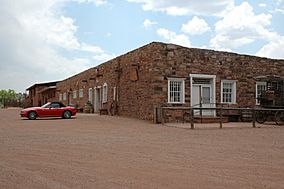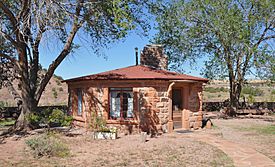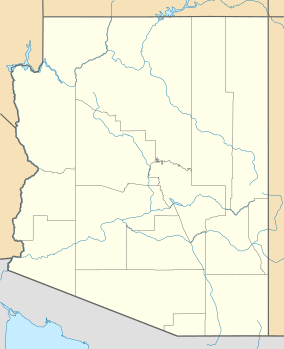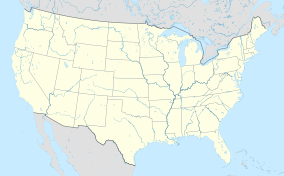Hubbell Trading Post National Historic Site facts for kids
Quick facts for kids Hubbell Trading Post National Historic Site |
|
|---|---|

Hubbell Trading Post
|
|
| Location | Apache County, Arizona, United States |
| Nearest town | Ganado, Arizona |
| Area | 160 acres (65 ha) |
| Established | 1878 |
| Visitors | 39,361 (in 2018) |
| Governing body | National Park Service |
| Website | Hubbell Trading Post National Historic Site |
|
Hubbell Trading Post
|
|

Guest House
|
|
| Location | Ganado, Arizona |
|---|---|
| Built | 1878 |
| Architect | John Lorenzo Hubbell |
| NRHP reference No. | 66000167 |
| Significant dates | |
| Added to NRHP | October 15, 1966 |
| Designated NHL | December 12, 1960 |
The Hubbell Trading Post National Historic Site is a special place in Ganado, Arizona. It's located on Highway 191, north of Chambers. This site is important because it shows how two cultures, the Navajo and the settlers, met and traded with each other. It's like a bridge between their worlds.
Contents
History of Hubbell Trading Post
In 1878, a man named John Lorenzo Hubbell bought this trading post. This was ten years after the Navajos were allowed to return to their homes in the Ganado area. They had been forced to leave their land and live in Bosque Redondo, New Mexico. This difficult time is known as the "Long Walk of the Navajo."
The Hubbell Trading Post was recognized as a National Historic Landmark in 1960. This means it's a very important historical place in the United States.
When the Navajos returned from the Long Walk in 1868, their lives had changed a lot. Their animal herds were gone, and their fields were destroyed. This led to tough economic times for them in the late 1800s. Because of this, trading became very important for their survival.
The main building of the trading post was built in 1883. It was made from heavy sandstone quarried nearby. Trading was not a new idea for the Navajos. Native American tribes in the Southwest had traded with each other for hundreds of years. During their time at Bosque Redondo, Navajos learned about many new items. These included things like flour, sugar, coffee, and tools.
When traders like Hubbell came, the types of products exchanged changed. Traders supplied items that the Navajos needed to add to their own goods. In return, the Navajos traded wool, sheep, and later, beautiful rugs, jewelry, baskets, and pottery. For many years, cash was not used in these trades.
The Hubbell family ran this trading post until 1967. Then, the National Park Service bought it. Today, the trading post is still active. It is run by a non-profit group called the Western National Parks Association. They continue the trading traditions that the Hubbell family started.
The Hubbell Trading Post National Historic Site is still on its original 160-acre homestead. This includes the trading post, the family home, other buildings, and a visitor center. Visitors can see weaving demonstrations and explore the store. The store still has its original wooden floor and walls.
John Lorenzo Hubbell's Story
John Lorenzo Hubbell had an Anglo father and a Spanish mother. He grew up in Pajarito Mesa, New Mexico. He arrived in the Ganado area in 1876, not long after the Long Walk. In 1878, he bought the trading post buildings from another trader. He was only 23 years old and single. He was learning to live among the Navajos, a people he didn't know well. He quickly learned "trader Navajo," a simplified version of the language. John Lorenzo could speak three languages: English, Spanish, and Navajo.
Mr. Hubbell married a Spanish woman named Lina Rubi. They had two sons and two daughters. Their family home was expanded in 1902 to fit their growing family. It started as a simple adobe building. Over time, the Hubbell family made it a comfortable and beautiful home. Paintings, artifacts, and large Navajo rugs still decorate the inside. Unlike other traders, the entire Hubbell family lived at the trading post most of the year. They lived in the house until 1967.
The guest house was built in the early 1930s. It was made by Roman and Dorothy Hubbell, John Lorenzo's son and daughter-in-law. They built it to honor Mr. Hubbell. Dorothy Hubbell carved the inner wooden door. Many visitors stayed in the Hubbell home. These included artists, anthropologists, politicians, family friends, and regular travelers.
The guest house was built in the Hogan style. A Hogan (pronounced hoe-gone) is a traditional Navajo home. Most hogans are made of logs and have six or eight sides. Their doors always face east. Mr. Hubbell even built several traditional hogans on the grounds for Navajos who traveled far to trade. The guest house was first called Pueblo Colorado. But it was often confused with the town of Pueblo, Colorado.
There was an important Navajo leader named totsohnii Hastiin (pronounced Toe-so-knee haaus-teen). This means "man of the big water clan" in Navajo. He was also called Ganado Mucho (pronounced gah-nah-doe-moo-cho), which means "many cattle" in Spanish. Mr. Hubbell renamed this place Ganado after him. Ganado Mucho's son, Many Horses, is buried on the property.
North of the trading post is the Pueblo Colorado Wash. This wash is the northern border of the Hubbell settlement. In some parts of the Ganado-Cornfields valley, the wash flows all year. Melting snow in spring and heavy summer rains can sometimes cause it to flood. In the Southwest, a good water source always attracted people. The Anasazi (pronounced Ah-na-eeh-son-ni), meaning "the ancient ones" in Navajo, lived in small villages here hundreds of years ago. The Navajos came later, and then the traders. All were drawn to the water.
The cone-shaped hill northwest of the trading post is Hubbell Hill. The family cemetery is at the top. Mr. Hubbell, his wife, three of his children, a daughter-in-law, a granddaughter, and a Navajo man named Many Horses are buried there. Many Horses was a local herdsman and the son of Ganado Mucho. He and Mr. Hubbell were close friends for many years.
Mr. Hubbell remained friends with many of his customers until he passed away in 1930. His younger son, Roman, then took over the business. When Roman died in 1957, his wife Dorothy managed the store for another ten years. In 1967, the National Park Service bought the site.
The trading post had corrals built with juniper logs standing upright. These corrals held lambs and sheep that Mr. Hubbell bought from Navajo stockmen. The animals stayed in the corrals until they could be moved to the railroad. Sometimes, Mr. Hubbell also kept beef cattle. Mr. Hubbell claimed 160 acres of land under the homesteaded laws before it was part of the reservation. When the reservation grew, it surrounded his property. Through a special act of Congress, Mr. Hubbell was allowed to keep his home.
Freight wagons brought supplies 56 miles to the store from Gallup, New Mexico. This trip took two to four days in good weather. On the way back to Gallup, the wagons carried large sacks of wool.
Building the Trading Post
Construction of the trading post barn began in 1897. Local people built the walls using local sandstone. The roofs were made in an ancient Anasazi style. They used layers of ponderosa pine beams, aspen poles, juniper bark, cornstalks, and dirt. Each layer was placed at a right angle to the one below it. Mules and pulleys were used to lift the heavy beams into place.
The timbers came from about 12 miles (19 km) east of Ganado Village. This area is high enough for ponderosa pine trees to grow. The aspen poles came from farther away, from the Chuska Mountains. These mountains are about 100 miles north and stretch across the Arizona/New Mexico state line. The barn was finished in 1900.
Images for kids







